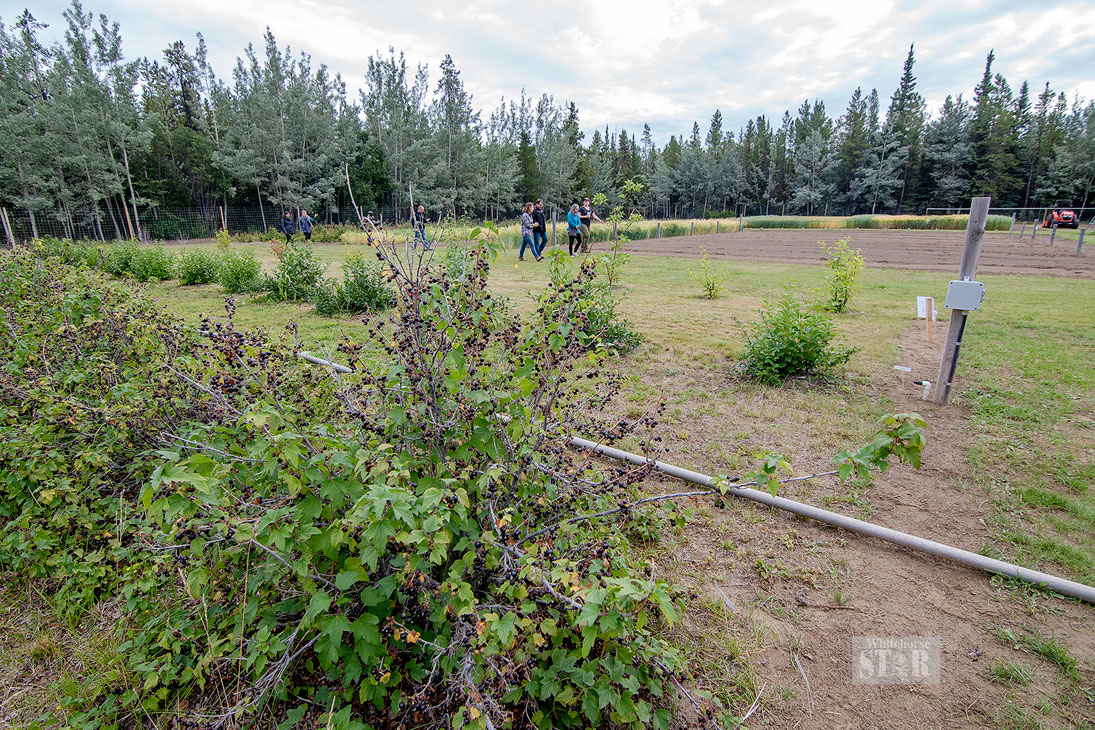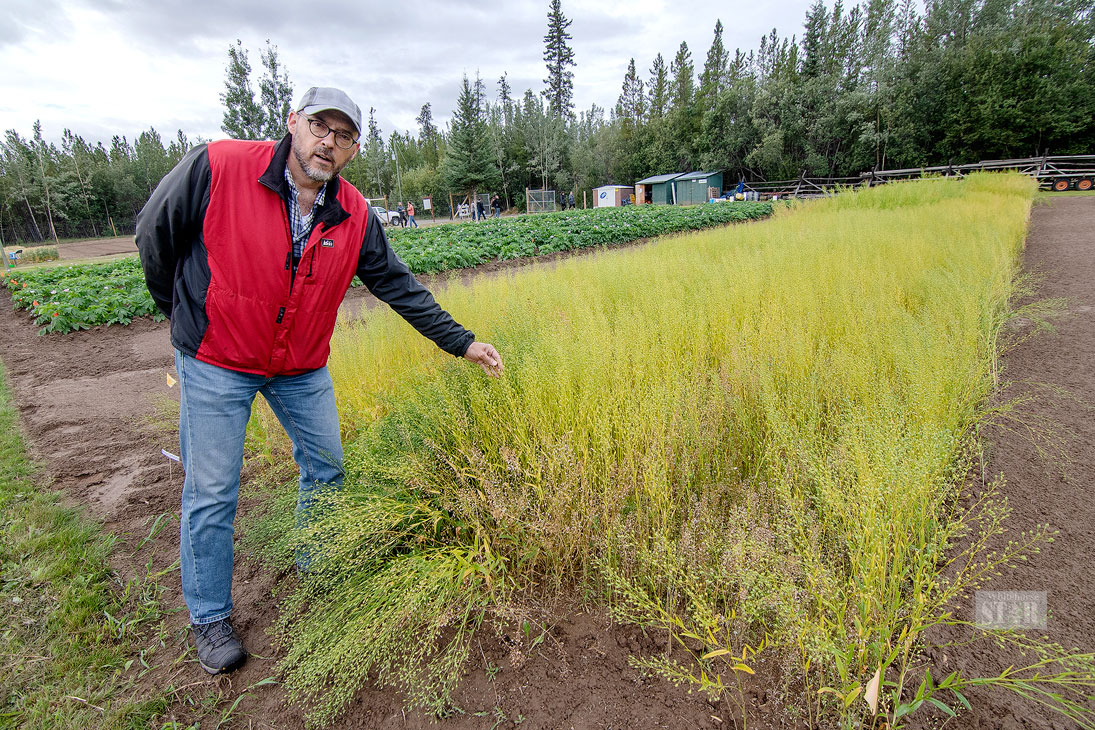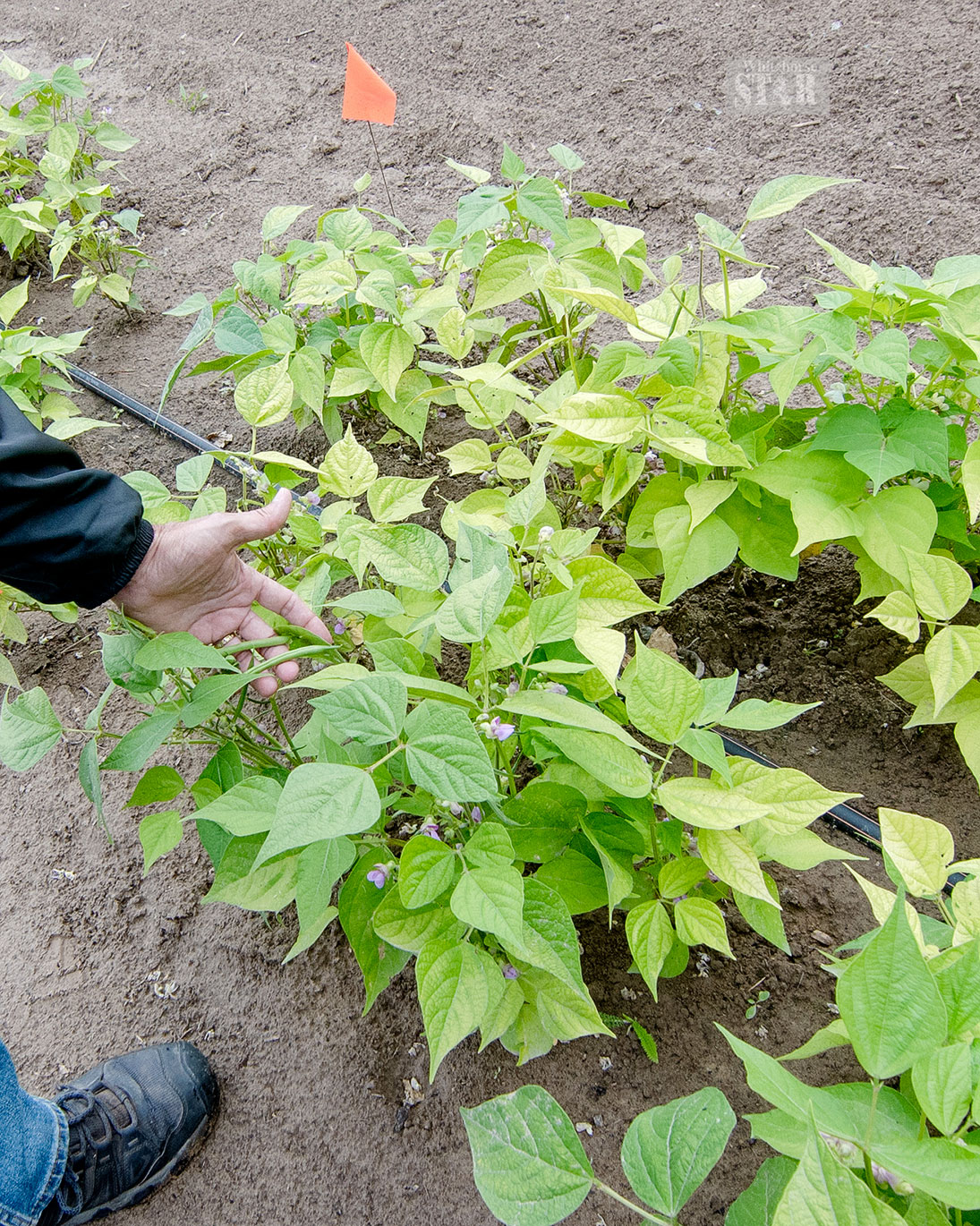
Photo by Vince Fedoroff
BOUNTIFUL CURRANTS – The annual Agricultural Demonstration Day took place last Wednesday at the Gunnar Nilsson and Mickey Lammers Research Forest. Here, the black currants are in the foreground.

Photo by Vince Fedoroff
BOUNTIFUL CURRANTS – The annual Agricultural Demonstration Day took place last Wednesday at the Gunnar Nilsson and Mickey Lammers Research Forest. Here, the black currants are in the foreground.

Photo by Vince Fedoroff
INTRIGUING POTENTIAL – Tours of the research fields and a barbecue were part of last Wednesday’s annual Agricultural Demonstration Day at the Gunnar Nilsson and Mickey Lammers Research Forest. Here, Randy Lamb is seen with the Camelina sativa, an oil crop similar to canola that Yukon farmers are interested in.

Photo by Vince Fedoroff
BEANS GALORE – Randy Lamb points out the bush beans last Wednesday at the Gunnar Nilsson and Mickey Lammers Research Forest.
The territorial government’s research farm has proved that oats, barley, multiple haskap varieties and Camelina oil seeds will flourish at Yukon farms.
The territorial government’s research farm has proved that oats, barley, multiple haskap varieties and Camelina oil seeds will flourish at Yukon farms.
The discovery was shared with local growers at their annual demonstration day held last week.
“Having a research farm is really useful,” Sonny Gray, the president of the Yukon Agricultural Association, told the Star.
“That’s public knowledge that farmers can tap into whenever we need it, regarding what we’re going to plant next year.”
The farm hosted the demo day at the Gunnar Nilsson and Mickey Lammers Research Forest, located off the North Klondike Highway near Whitehorse.
On hand were 60 attendees, comprised of local food producers and agriculture enthusiasts. They gathered for a tour of the research fields, a locally-sourced barbecue and a breakdown of the year’s findings.
Randy Lamb, a research farm agrologist, said the studies have the potential to open doors for Yukon farmers.
Many of their agriculture studies are spurred by requests from local growers.
“Instead of a farmer wasting hundreds of thousands of dollars (testing a new crop), we’ll give it a try,” Lamb said.
This year, the research centre planted camelina sativa oilseed at the request of Steve Mackenzie-Grieve, the owner of the Yukon Grain Farm.
Camelina is a “high-value” crop that flourishes in cool climates, matures early and requires less water than canola.
The oil is also packed with omega-3 fats and can be cooked at hot temperatures, making it a potential health alternative for frying foods.
“It’s very trendy; people are excited about it,” Lamb said. “Our organic growers are really excited about it.”
Mackenzie-Grieve was already impressed with the oilseed’s maturation after five years of trial on his own farm.
He hoped the research farm would have similar success, potentially with different varieties than he had access to.
“As a farmer, I don’t necessarily keep track of things the way that they would,” Mackenzie-Grieve said.
He added that he plans to start growing camelina in larger volumes.
“It’s a high-quality seed, and we need it in our rotation,” he said.
“Right now, there are no oil seeds that will grow in our environment because it’s too cool.”
Lamb said the farm had success with multiple varieties of haskap berries as well as the camelina. Because it’s a popular berry for Yukon growers at the moment, farmers were able to compare the haskap varieties side-by-side.
The research centre also tested different grains, including barley and oats. Part of that exploration included the potential to grow malting barley, which is one of the four main ingredients in beer.
“If we can connect the growers with the brewers, we have a new industry up here,” Lamb said. “We’re always looking for that value- added aspect.”
Bob Baxter, a co-owner of Yukon Brewing, said that using local barley for brewing is probably not possible because the grain needs to go through a malting process after harvest.
At the moment, there aren’t enough breweries in the territory to warrant a malting facility. Yukon Brewing imports most of their malted barley from Biggar, Sask.
“It would be a challenge, for sure,” Baxter said. “Never say never; I know there are a couple breweries that have built malting facilities, but not on this scale.”
Still, Baxter said their brewery tries to use local ingredients whenever possible.
In the past, they’ve made spirits from locally grown haskap berries and beers from fireweed and Watson Lake honey.
“If we can find it, and source it, we will find a way to do that,” he said.
As the summer winds to a close, Lamb said, the research farm is already planning next year’s plots. Perennial wheat grass and bush beans are two of the things that will be included.
The research farm is three acres, which Lamb says is small but well-utilized.
Sometimes, they will pair with bigger farms to work on large-scale projects. They also have a small market garden with four types of vegetables.
At the end of the summer, a truckload of vegetables will be donated to the food bank.
Gray believes this is an important time in history for the Yukon to be doing this level of agricultural research, particularly as weather patterns warm.
“There’s a lot of interesting and exciting opportunities growing in the Yukon,” Gray said.
“Agriculture is set to become a really valuable industry. That’s all we can hope for: to have that self-sustainability.”
In order to encourage thoughtful and responsible discussion, website comments will not be visible until a moderator approves them. Please add comments judiciously and refrain from maligning any individual or institution. Read about our user comment and privacy policies.
Your name and email address are required before your comment is posted. Otherwise, your comment will not be posted.
Comments (1)
Up 4 Down 0
Mary Lynn Drul on Aug 14, 2019 at 10:31 am
I am happy to read Yukon agriculture is growing. We so need to grow at home.